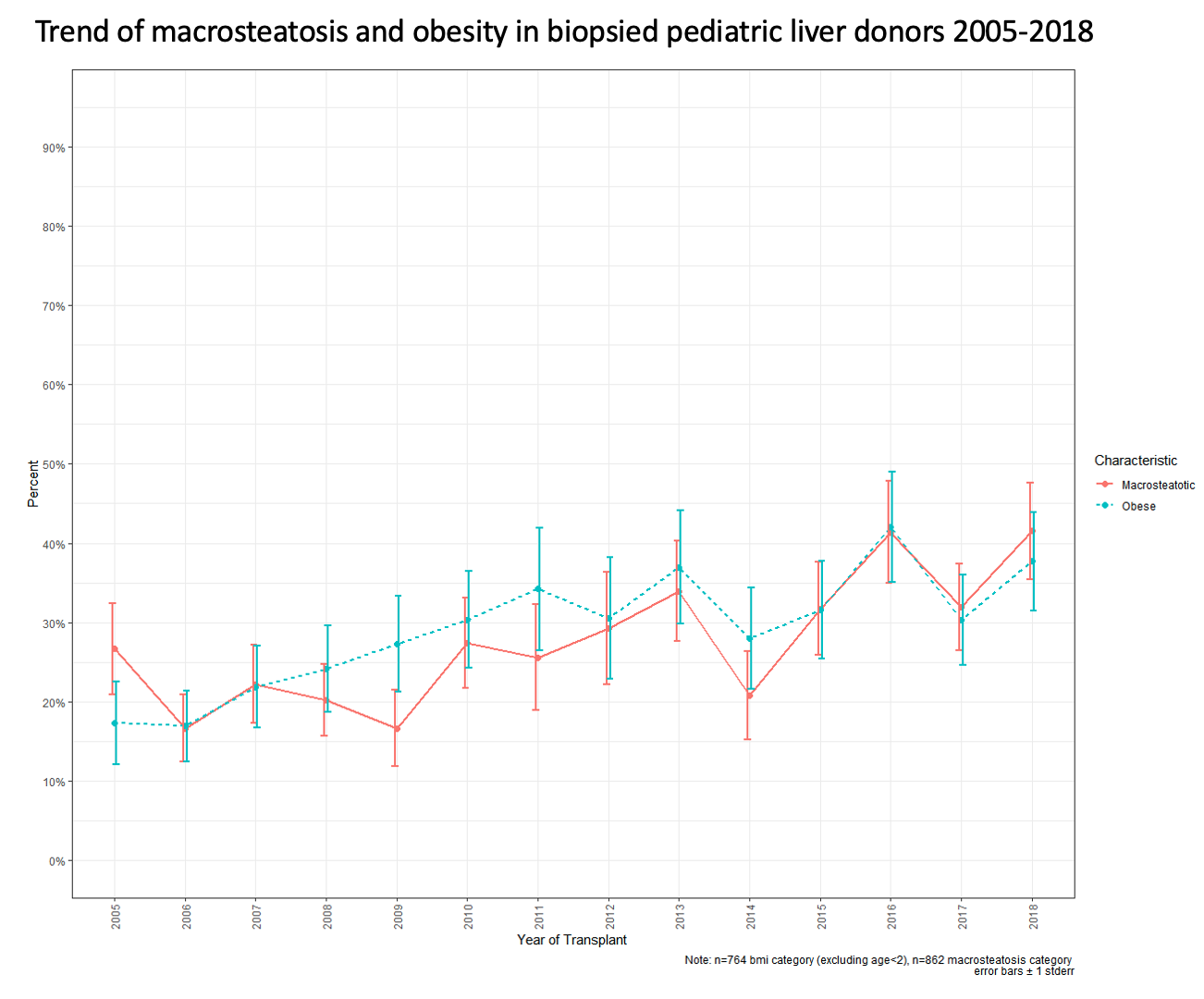Macrosteatosis in the US Pediatric Deceased Liver Donor Population, 2005-2018
University of Alabama School of Medicine, Birmingham, AL
Meeting: 2021 American Transplant Congress
Abstract number: 1176
Keywords: Biopsy, Obesity, Pediatric, Survival
Topic: Clinical Science » Liver » Liver: Pediatrics
Session Information
Session Name: Liver: Pediatrics
Session Type: Poster Abstract
Session Date & Time: None. Available on demand.
Location: Virtual
*Purpose: The pediatric obesity epidemic is associated with early signs of non-alcoholic fatty liver disease (NAFLD) such as increased hepatic macrosteatosis and liver enzymes. In adults, donor macrosteatosis in liver allografts is associated with graft loss, but this association has not been examined in pediatric donors.
*Methods: Our study included all pediatric potential whole liver donors from 2005-2018 who had a liver biopsy in the Scientific Registry for Transplant Recipients (SRTR) (n = 862) and their recipients (n = 862). Macrosteatosis was abstracted from biopsy reports uploaded to DonorNet and compared to values in the SRTR standard analytic file. If the biopsy report was missing, the SRTR value was used. If the two sources differed, the value in the biopsy report was used preferentially. Recipients of pediatric macrosteatotic liver grafts (>5% macrosteatosis; n = 193) were matched 1:1 to recipients of pediatric non-macrosteatotic grafts (<5% macrosteatosis) by propensity score matching on donor and recipient variables. All-cause graft loss was estimated via Kaplan-Meier analysis and a Cox proportional hazards model was fit with adjustment by covariates that remained unbalanced after matching.
*Results: From 2005-2018, there was a significant increase in the proportion of biopsied pediatric liver donors with macrosteatosis (26.7% in 2005 and 41.5% in 2018; P < 0.001), consistent with a significant increase in pediatric donor BMI over the study period (Figure 1). Over the study period, the median degree of macrosteatosis among macrosteatotic donors was 10% (IQR 5-30). From 2005-2018, the proportion of biopsied deceased pediatric whole liver donors >2 years old were obese based on BMI percentile for age and sex increased from 17.3% to 37.7% (P = 0.002). On Kaplan-Meier analysis, there were no significant differences in all-cause graft loss between the two groups at 90 days (stratified log-rank, P = 0.14) or 8 years (stratified log-rank, P = 0.27) post-transplant. A Cox proportional hazards model also showed no significant difference between the groups at 90 days (HR = 0.48; 95% CI = 0.18-1.27) or 5 years (P > 0.05) post-transplant.
*Conclusions: Pediatric liver donors between 2005-2018 became more obese with a greater proportion of macrosteatosis. Macrosteatosis did not appear to adversely affect outcomes, but if current trends in obesity and macrosteatosis continue, this might change.
To cite this abstract in AMA style:
Purvis J, Dhall D, McLeod C, Sheikh S, Cannon R, Frey K, Locke J, Orandi B. Macrosteatosis in the US Pediatric Deceased Liver Donor Population, 2005-2018 [abstract]. Am J Transplant. 2021; 21 (suppl 3). https://atcmeetingabstracts.com/abstract/macrosteatosis-in-the-us-pediatric-deceased-liver-donor-population-2005-2018/. Accessed January 2, 2026.« Back to 2021 American Transplant Congress

